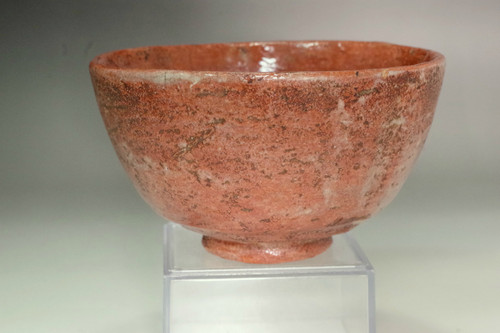Attributed to Raku 8th Tokunyu (1745-1774) Antique RAKU teabowl #5331
- SKU:
- 5331
- Shipping:
- Free Shipping
width: approx. 13cm (5 1⁄8in)
height: approx. 7.5cm (2 61⁄64in)
weight: 304g
This tea bowl, handed down through generations in an old Japanese household, is attributed to Raku Tokunyu (1599–1656), the 8th-generation head of the Raku family and a central figure in early Edo period tea ceramics. The bowl features a warm reddish glaze with fine speckling and iron-rich accents, giving it a rustic yet refined presence. Its hand-formed body, with gentle asymmetries and a soft, tactile quality, reflects the essential aesthetics of Raku ware. Despite its substantial form, the bowl feels light and intimate in hand, inviting quiet reflection. The small but stable foot is well-proportioned, contributing to the overall harmony of the piece. The condition is excellent, with no noticeable chips or cracks along the rim or base. Tokunyu was known for deepening the spiritual dimensions of tea ceramics, strongly influenced by the wabi-sabi philosophy. This bowl exemplifies that vision, making it not only a functional vessel for tea but also a valuable cultural artifact for connoisseurs of Japanese ceramic arts and tea ceremony traditions.
Raku Kichizaemon 8th Tokunyu
1745-1774
male
raku pottery
He was born as the eldest son of Chonyu, the 7th head. He was named Sokichi at birth and he was later renamed Eisei. He inherited the headship at 18, but when his father Chonyu passed away when he was 26, he also passed on the headship to his younger brother Sojiro (later Ryonyu), who was 15, because he had a weak constitution. He changed his name to Sabe and retired. He never married and passed away at the young age of 30. The name “Tokunyu” was given to him on the occasion of the 25th memorial service to his passing, and his posthumous name was changed to “Kengiin Tokunyu Nippu Koji.”
As Tokunyu fell ill at a young age, he was the head for no more than about nine years, and even if we assume that he continued to make pottery until his death, the period was short and Tokunyu’s number of works is the smallest in the family’s history. Moreover, since Tokunyu’s works are from his youth, he was not able to properly develop his own individuality or originality, but they are already well-made as chawan (teabowls).
Many of the chawan reveal a strong influence from his father Chonyu, and we can also sense how he sought to learn from the Rikyi-style Chojiro chawan, which could be termed the basics of Rake chawan. This is particularly evident in his red chawan, and we may sense an innocence in the youngish, honest attitude with which he tried to come to terms with the spirit of tea and the Raku chawan at such a young age.
He also made black Raku chawan that were exceptionally well-made as chawan, as can be seen in his “Joban” and the Kamenoe chawan “Mandai no tomo.” However, it does not seem that his black glaze achieved an original quality, so it is probable that he used the glaze of his father Chonyu.
Representative works include the aforementioned “Joban” and “Mandai no tomo,” as well as some red chawan that give off an air of innocence.















